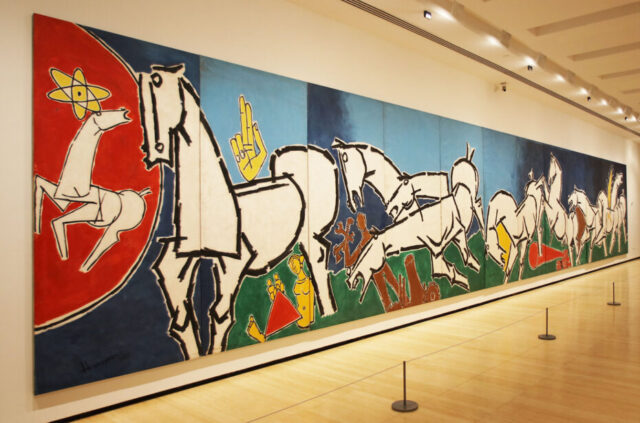By Zach Nickels, Dan Pollack

A recent filing in the U.S. District Court for the Southern District of New York provides yet another example of the importance of understanding the intersection of personal property rights, licences, copyright and non-fungible tokens (“NFTs”) and the distinctions between them.
The Claim
In TAMARINDART, LLC v. Raisa Husain and Owais Husain as Administrators of the Estate of Maqbool Fida Husain,[1] the plaintiff TamarindArt (“Tamarind”), a fine art gallery located in New York City, filed a complaint in response to a cease-and-desist letter it received from the estate of the late artist Maqbool Fida Husain (“Estate”). The Estate’s cease-and-desist was aimed at derailing Tamarind’s imminent NFT project based on Husain’s famous painting entitled “Lightning”, accusing them of copyright infringement. In their complaint, Tamarind seeks, among other things, a declaratory judgment of non-infringement of copyright purported to be owned by the Estate and monetary damages in an amount determined at trial.
The Facts
Tamarind purchased the 60-foot-long “Lightning” in 2002 for $400,000, and upon the sale Husain (the work’s creator and copyright owner) allegedly granted Tamarind an “exclusive, royalty-free, worldwide license to display, market, reproduce and resell all or any part of the artwork”, which included “all digital and off-line media”.[2]
However, beyond this expansive licence, Tamarind also claims that Husain offered “all the rights [in Lightning] including the copyright” such that Tamarind would be able to print posters, graphics or any digital works of Lightning in order to recoup some of the money spent purchasing the work.[3]
Eventually, Husain passed in 2011, and earlier this year Tamarind prepared to launch the “LightningNFT project” which involved the release of a still undetermined number of NFTs incorporating aspects of Lightning with 62 unique traits.
Lightning Strikes… Twice?
On January 8, 2022 Tamarind received the cease-and-desist letter from the Estate, which claimed that although Tamarind owned the physical artwork, it did not own the copyright in the work, and therefore had no right to reproduce, distribute copies or create derivative works based on the work or display it publicly.[4]
Considerations of Interest (From a Canadian Copyright Perspective)
Although this dispute has yet to be resolved, it highlights some of the issues that both copyright holders and licensees can face in the burgeoning NFT-minting industry, and provides an opportunity to reflect on some important considerations when dealing with copyright and NFTs:
Personal Property Rights Are Not The Same As Copyrights
- Owning a physical copy of a work in which copyright subsists =/= owning the copyright in the work.
- When you buy a copy of a work, you have personal property rights in that work. You can even re-sell that work according to what is known as the doctrine of exhaustion where the copyright holder’s exclusive rights to distribution are “exhausted” after the first purchase (think second hand books or vintage vinyl). However, because you do not have copyrights in the work, you cannot reproduce or make copies of that work.
- This situation recently raised its ugly head out of the sand when a group of “Cryptobros” purchased a copy of a rare book about Alejandro Jodorowsky’s “Dune” for $2.66M and planned to make NFTs and an animated limited series following the acquisition. Little did they know, the purchase of the book did not confer any copyrights in the book – just the rights to the book itself!
What Does Your Licence Actually Entail?
- As copyright holders/licensors and licensees, it is critical to understand the scope and the nature of any intellectual property licence that you are a party to. Consider: are you a non-exclusive or exclusive licensee? What rights to use the work and in what manner can you use the work as a licensee?
- For example, the popular NFT platform NBA Top Shot’s Terms of Use clearly set out that NFT purchasers are granted a “non-exclusive, non-transferable, royalty-free license to use, copy and display the [NFT]…”, and not true ownership of the NFT (in the traditional sense) nor any copyright in the work subsisting in the NFT. Who reads Terms anyways?
Get It In Writing!
- Any assignment of copyright must be made in writing and signed by the copyright owner (or duly authorized agent) under section 13(4) of Canada’s Copyright Act.
- In the event that slip—ups are made when parties’ intentions are such that copyright should have been assigned upon the completion of a transaction, retroactive assignments of copyright can be drafted.
Obtain A Waiver of Moral Rights
- Moral rights can only be waived under section 17.1(2) of the Copyright Act – they cannot be assigned like copyrights can.
- It’s critical to ensure that if you are planning to modify a work in which you have obtained the copyrights (perhaps to mint some NFTs?) that you also obtain a waiver of the author’s moral rights – otherwise, you could expose yourself to liability for infringing their rights to paternity or integrity!
Substantial Parts Unknown…
- As a non-copyright owner or non-licensee, even if you only reproduce “part” of a copyright protected work as an NFT or otherwise, you can still be found liable for copyright infringement if the portion constitutes a substantial part of the work.
- According to the Supreme Court of Canada’s seminal decision in Theberge v. Galerie d’Art de Petit Champlain Inc.,[5] the “principal economic benefit [of copyright]… to an author… is the sole right to reproduce the work or any substantial part thereof in any material form whatever”.[6] In other words, if an NFT or other derivative created by a non-copyright owner includes a substantial part of a work in which copyright subsists, the non-copyright owner could be opening themselves up to liability for copyright infringement under section 27 of the Copyright Act.
[1] 1:22-cv-595 (S.D.N.Y) [TamarindArt].
[2] See TamarindArt at para. 2.
[3] See TamarindArt at para. 32.
[4] See TamarindArt at para. 4.
[5] 2002 SCC 34 [Theberge].
[6] See Theberge at para. 12.
